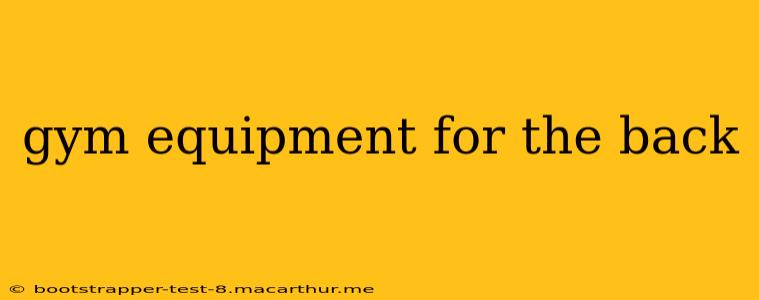A strong back is crucial for overall health, posture, and preventing injuries. But knowing which gym equipment best targets your back muscles can be overwhelming. This guide explores the best gym equipment for building a powerful and resilient back, addressing common questions and providing expert insights.
What is the best gym equipment for lower back pain?
This question deserves careful consideration. It's important to note that if you're experiencing lower back pain, you should consult a doctor or physical therapist before starting any new workout routine. They can diagnose the cause of your pain and recommend appropriate exercises. That said, certain gym equipment can be beneficial after consultation with a professional. Low-impact machines are generally safer for those with back problems. These include:
- Rowing Machine: This is excellent for strengthening the entire back, particularly the lower back, while being gentle on the spine. The seated position provides support, reducing strain.
- Elliptical Trainer: While not directly targeting back muscles, the elliptical provides a low-impact cardio workout that can improve overall fitness and core strength, indirectly supporting back health.
- Back Extension Machine: Used correctly, this machine can strengthen the erector spinae muscles, crucial for lower back support. However, proper form is paramount to avoid exacerbating pain.
Always start with lighter weights and focus on proper form before increasing the intensity. Listen to your body and stop if you feel any pain.
What gym equipment is good for building back muscle?
For building substantial back muscle, a combination of equipment is ideal, targeting different muscle groups:
-
Pull-up Bar: This is a classic and highly effective exercise for building back width and thickness. It works the latissimus dorsi (lats), trapezius (traps), and rhomboids. Variations like chin-ups and assisted pull-ups cater to different fitness levels.
-
Barbell Rows: This compound exercise targets the entire back, focusing on the lats, rhomboids, and traps. It's incredibly effective for building muscle mass and strength. Variations like Pendlay rows and sumo rows offer different benefits.
-
Lat Pulldowns: A machine-based exercise that provides a safe and effective way to work the lats. The adjustable weight allows for progressive overload, crucial for muscle growth.
-
Seated Cable Rows: This exercise allows for isolated back muscle work, particularly targeting the middle back. The controlled movement minimizes the risk of injury and helps improve form.
What is the best back machine at the gym?
There isn't a single "best" back machine; the ideal choice depends on your goals and fitness level. However, some consistently popular and effective options include:
- Lat Pulldown Machine: Its versatility and adjustable weight make it a favorite among gym-goers.
- Rowing Machine (Concept 2, etc.): Offers a full-body workout with a significant back component.
- Back Extension Machine: Excellent for lower back strengthening, but requires proper form.
What machines work the lower back at the gym?
The lower back is often engaged in compound exercises. However, certain machines directly target this area:
- Back Extension Machine: As mentioned before, this machine is designed specifically to work the erector spinae muscles, essential for lower back support and strength.
- Hyperextension Machine: Similar to the back extension machine, but often provides a more pronounced stretch.
How can I strengthen my back at the gym without weights?
Bodyweight exercises can be incredibly effective for building back strength, even without weights:
- Pull-ups (if you can do them): The ultimate bodyweight back exercise.
- Australian Pull-ups (using a bar): A modified pull-up for beginners.
- Inverted Rows: These can be performed using a sturdy table or bar, offering a progression towards pull-ups.
- Supermans: These are excellent for strengthening the lower back.
- Back Extensions (without added weight): Focus on controlled movements and full range of motion.
Remember, proper form is always paramount regardless of the equipment or exercise used. Start slowly, focus on technique, and gradually increase the intensity as your strength improves. Consult a qualified fitness professional for personalized advice and guidance.
